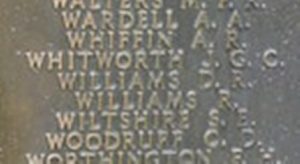Llandderfel is a small village situated near Bala, in the ancient county of Merionethshire. The men of the village who fell during both World Wars are commemorated on the village war memorial, which takes the shape of a Celtic Cross, and is located at the junction of the B4401 and B4402 roads in the heart of the village. The memorial was originally unveiled on 5 August 1922, and the additional names of the fallen of WW2 were added afterwards.
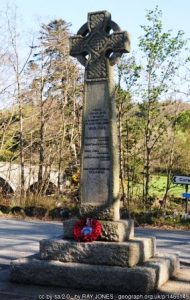
The Great War, 1914-1918
John William Davies, Private, 61072, Royal Welsh Fusiliers. John was the son of John and Jane Davies, of Rhosygwaliau, Bala. He married Catherine Hughes, of Minafon, Llandderfel, early in 1917. John had enlisted into the Royal Welsh Fusiliers at Dolgellau, and was posted out to France in the spring of 1917, joining the 2nd Battalion, Royal Welsh Fusiliers, which was attached to 19 Brigade, 33rd Division. John would have seen his first major action when the Division took part in the Battle of the Scarpe and then alongside the Australians at Bullecourt, before the Division headed to Ypres. The Division took part in the Battle of the Menin Road and launched a costly assault on Polygon Wood. The Division wintered in the Ypres Salient, carrying out the normal system of rotation of units in the trenches over the coming months. On 20 January 1918, the 2nd RWF was holding the front line when an aircraft circled above them. Shortly afterwards an artillery barrage came down upon their positions, which killed just one man, John. He was 26 years old and is buried in Oxford Road Cemetery, Belgium. His brother, Thomas Hugh Davies, also fell.
Edward Hughes, Private, 25086, Royal Welsh Fusiliers. Edward was the son of William and Grace Hughes, of Cae Cyndel, Llandderfel. He worked as a Carter at Llandrillo prior to enlisting at Corwen into the Royal Welsh Fusiliers on 1 February 1915. He was posted to Llandudno, joining the 17th Battalion, Royal Welsh Fusiliers, but on 19 June 1917 was posted to Litherland Camp, Liverpool, joining the 3rd Battalion, Royal Welsh Fusiliers. On 30 September 1915 Edward embarked for France, joining the 1st Battalion, Royal Welsh Fusiliers, which was attached to 22 Brigade, 7th Division. The Division had suffered heavy casualties during the Battle of Loos during its capture of the Quarries. By the summer of 1916, the Division was on the Somme, and took part in the opening offensive of 1 July 1916, capturing Bois Francais and Mametz village. The Division then fought at the Battle of Bazentin, and the Attacks on High Wood, becoming the first troops into High Wood. The Division then took part in the Battle of Delville Wood, and the Battle of Guillemont, before spending the winter on the Ancre. In March 1917 it followed up the German Retreat to the Hindenburg Line, and took part in Flanking Operations Round Bullecourt, taking part in terrible fighting alongside the Australians. Later in the year the Division moved to Ypres, and again saw terrible fighting in the Battle of Polygon Wood. On 4 October the Division again fought alongside the Australians, during the Battle of Broodeseinde, successfully pushing the line forwards to the east of Polygon Wood. Edward was killed just before his battalion was relieved on 10 October 1917. The 24-year-old has no known grave and is commemorated on the Tyne Cot Memorial, Belgium.
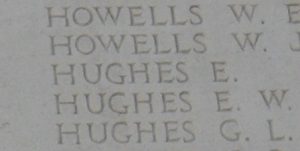
John Hughes, Lance Corporal, 16434, Welsh Regiment. John was born at Llandderfel, but had moved away some years prior to the war, to work in Liverpool as a cotton warehouseman. He was in South Wales at the outbreak of war, and enlisted at Penrhiwceiber into the 10th Battalion, Welsh Regiment. The battalion, known as the 1st Rhondda, was made up mostly of coalminers from the Rhondda Valley, and formed at Porthcawl before moving to Rhyl to join the 43rd (Welsh) Division. The Division trained in North Wales before moving to Winchester in the summer of 1915, where it became renumbered 38th (Welsh) Division, and the 10th Welsh formed part of 114 Brigade. The Division moved to France on 2 December 1915 and moved to the Nursery Sector near Fleurbaix for trench initiation alongside the Guards Division. The Division then held a sector of the line near Cuinchy, a particularly nasty sector where underground warfare was rife. On 9 March 1916 the 10th Welsh was on the left of the Divisions line, near the La Bassée Canal, when the Germans exploded an underground mine near their positions. John was one of two men killed as a result of the explosion, while six more were wounded. John is buried in Guards Cemetery, Windy Corner, Cuinchy, France.
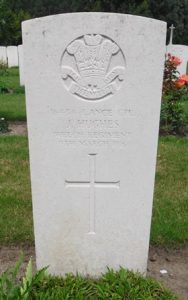
Edward Vaughan Jones, Private, 40062, Royal Welsh Fusiliers. Edward was the son of Thomas and Anne Jones, of 1, Church Street, Llandderfel. He worked as a Draper at Liverpool prior to the war. Edward enlisted at Liverpool into the 3rd Battalion, Royal Welsh Fusiliers on 15 November 1915 and was placed on the Army Reserve. Edward was mobilised on 21 January 1916 and posted to the 22nd Battalion, Royal Welsh Fusiliers at Kinmel Park for training. He embarked at Devonport on 11 October 1916 and disembarked at Basra on 17 November, prior to joining the 8th Battalion, Royal Welsh Fusiliers, which was attached to 40 Brigade, 13th (Western) Division. The Division had moved to Mesopotamia from Egypt in February 1916, and took part in the attempts to relieve the besieged garrison at Kut. However, after these efforts failed and Kut fell, the British force in the theatre was built up and reorganised. The Division then fought at the Battle of Kut al Amara, then at the capture of the Hai Salient and the capture of Dahra Bend. They took part in the passage of the Diyala, in the pursuit of the enemy towards Baghdad. Edward was killed in action during the advance to Baghdad, on 25 January 1917. The 21-year-old has no known grave and is commemorated on the Basra Memorial, Iraq.
Elias Jones, Private, 14370, Machine Gun Corps. Elias was the son of William Henry Jones and Jane Jones, of Tyn-y-Llwyn, Glanrafor, Llandderfel. He enlisted into the Royal Welsh Fusiliers, but was later transferred to the Machine Gun Corps. Very little else is presently known of his service, or unit, but he was possibly wounded towards the end of the war, as he died at the 2nd Scottish General Hospital, Edinburgh on 21 March 1919, aged 22. His remains were brought home for burial in Holy Trinity Churchyard, Trefnant.
Kenneth Jervis Key, Private, 58577, Royal Engineers. Kenneth was born in Toxteth in 1895, the son of Thomas Key and Mary Ellen Key (nee Jervis). His father died in 1915, and his mother moved to Llandderfel. Kenneth enlisted into the Welsh Regiment, and was posted to Salonika, joining the 11th Battalion, Welsh Regiment, which was attached to 67 Brigade, 22nd Division. He was then transferred to the Lancashire Fortress Company, Royal Engineers, and later transferred to the 999th Area Employment Company, Labour Corps, probably due to failing health. Kenneth died of disease in Salonika on 24 November 1918, aged 23. He is buried in Mikra British Cemetery, Kalamaria. He is not commemorated on the Llandderfel memorial.
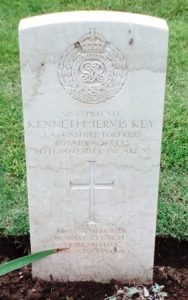
Cerwyn Ewart Phillips, Private, 15448, Welsh Regiment. Cerwyn was born in Swansea in 1893, the son of Thomas and Mary Phillips. The family had moved to London by 1901, where Thomas ran his own dairy business in Kensington. Following the death of his father, his mother Mary brought the family back to her native Llandderfel, and lived at Pate Lodge. Cerwyn enlisted at Cardiff into the 11th Battalion, Welsh Regiment in August 1914. The battalion was formed at Cardiff, and became known as the Cardiff Pals, becoming attached to 67 Brigade, 22nd Division. The Division moved to France on 6 September 1915, taking over positions in the Somme sector, but soon afterwards the Division received orders to entrain for Marseilles and from there embarked for Salonika, arriving on 8 November 1915. The Allies had sent forces to Salonika to aid the Greek army, following the Austrian and Bulgarian offensive on Serbia, which had forced the Serbian army to withdraw from their own country into Greece. Upon its arrival, the Division took part in the Retreat from Serbia during December 1915. During August 1916 the Division fought at the battle of Horseshoe Hill, then during September 1916 fought at the battle of Machukovo. Cerwyn was killed in action near the Struma river on 11 October 1916. The 23-year-old is buried in Salonika (Lembet Road) Military Cemetery, Greece.
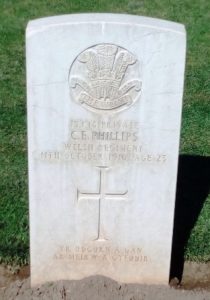
Meirion Roberts, Sergeant, 171720, Canadian Infantry. Meirion was born on 26 June 1892, the son of Robert and Catherine Roberts, of Llety’r’ Awen, Llandderfel. He was a Tailor, and had served for four years with the 7th Battalion, Royal Welsh Fusiliers, a Territorial unit, prior to emigrating to Canada. Meirion enlisted into the 83rd Overseas Battalion, Canadian Infantry at Toronto on 14 August 1915. He sailed with the battalion for England aboard the SS Olympic on 28 April 1916, and upon arrival on 7 May, the battalion was sent to Shorncliffe Camp. On 7 September 1917 Meirion was posted to France, joining the 3rd Battalion, Canadian Infantry, which was attached to the 1st Canadian Brigade, 1st Canadian Division. He joined the Division at Ypres, in time to take part in the Battle of Passchendaele, where the Canadians help take Passchendaele village and ridge by 10 November 1917. Meirion was wounded on 4 February 1918 and was taken to the 6th Canadian Casualty Clearing Station, suffering from gas inhalation, before being sent to No 18 General Hospital at Camiers. After recovering, on 15 March 1918 he re-joined the battalion, which by then was in the southern Somme sector. Meirion then took part in the Battle of Amiens on 8 August, an action which saw the Germans defeated around Villers-Bretonneux, and which famously broke their fighting spirit. From then on, the Allies went on the offensive, launching a massive offensive along most of the Western Front on 21 August. The Canadians advanced, together with the Australians, from their positions near Villers-Bretonneux, towards the Hindenburg Line, and saw action around Damery between 15 and 17 August, before taking part in the Battle of the Scarpe between 26 and 30 August. By 1 September the 3rd Battalion, Canadian Infantry received orders for its part in the Divisions assault on the Drocourt-Quéant Switch Line, and over the next two days saw heavy fighting. By 15 September the Canadians had moved to the Croisilles area to take part in the attack in front of Arras, towards Cambrai. Meirion was wounded soon afterwards and died of his wounds on 27 September 1918. The 26-year-old is buried in Quéant Communal Cemetery British Extension, France.
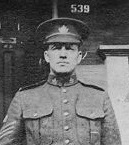
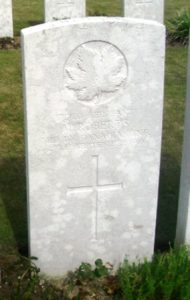
Harold Henry Scott, Private, S/26798, Army Service Corps. Harold was born in Burma, the son of James William Scott and Eliza Scott. When his father retired from the army, the family returned to Britain, and lived at 11, Percy Road, Chester. Harold found work as a Clerk upon the family’s return to England, and enlisted into the Army Service Corps at Chester on 4 August 1908 and was posted to Chatham, where he worked as a Clerk at the Cashier’s Office, Western Command. He left the army on 9 August 1912, joining the Army Reserve, and returned to Chester. Harold married Louisa Kate Hughes, a domestic servant for a family at Rose Villa, Willaston, at Chorlton, Lancashire on 20 May 1913. Harold re-enlisted into the Army Service Corps at Aldershot on 6 August 1914 and was posted to France with the BEF. On 10 June 1915 Harold was sent home, due to his health, after being found to have contracted tuberculosis, and was discharged as medically unfit on 17 July 1915. Harold was then sent to hospital at Stockport, where he died of tuberculosis on 12 January 1916, aged 26. He is buried at Stockport (Willow Grove) Cemetery. Harold is not commemorated on the Llandderfel memorial.
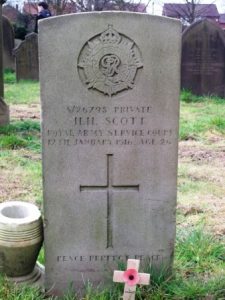
Kenneth Sheriff, Second Lieutenant, The Queen’s Own (Royal West Kent Regiment). Kenneth was born at Helensborough, Dumbarton, the son of James Sheriff and Mary Sheriff. His father was a wealthy Scottish tea plantation owner, who bought Crogen Hall, Llandrillo. Kenneth entered Rugby School in 1909 and represented the school in gymnastics. Upon leaving Rugby, he entered Birmingham University, but a month later war was declared, and he sought a commission into the 3rd Battalion, Queen’s Own (Royal West Kent Regiment). On 29 May 1915, he went to France, and was attached to the 2nd Battalion, Border Regiment, which was attached to 20 Brigade, 7th Division. Kenneth saw his first major action during the Battle of Loos on 25 September 1915. The Division took part in the initial assault north of the Vermelles-Hulluch road, facing the Quarries and a series of strong-points, and suffered badly from the British cloud gas, which had not blown onto the German lines as planned, but still attacked and got badly cut up by German machine gun fire and artillery. Despite this, the Division seized the Quarries and only failed to penetrate the third German line due to the relative weakness of the numbers of men that got through. The Division remained in the Givenchy sector after the closure of the battle. On 19 June 1916 the 2nd Border Regiment was in the lone at Givenchy, when Kenneth was hit by a German sniper. He was evacuated to the hospital at Boulogne, where he died of his wounds on 23 June 1916, aged 19. He is buried in Boulogne Eastern Cemetery, France.
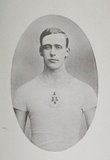
William Williams, Private, 43934, Royal Welsh Fusiliers. William was the only son of John and Jane Williams, of Penybanc, Sarnau, Llandderfel. He enlisted at Wrexham into the Royal Welsh Fusiliers, and after completing his training was posted to France, joining the 10th Battalion, Royal Welsh Fusiliers, which was attached to 76 Brigade, 3rd Division. William probably joined the battalion at the end of 1916, following its exploits at Delville Wood, and the Battle of the Ancre. By February 1917 the Division was at Arras, and from 9 April took part in the First Battle of the Scarpe. From 23 April the Division then fought in the Second Battle of the Scarpe, and also in the ensuing Battle of Arleux and the Third Battle of the Scarpe, where the Division captured Roeux. After a brief rest period to recover from its efforts at Arras, the Division went into reserve, before taking up the line again by 12 June, near Monchy and took part in another attack on 14 June. The Germans counter-attacked the following day, beginning a series of tit-for-tat actions over the coming days. William was badly wounded during this period, and died of his wounds in hospital at Étaples on 20 June 1917, aged 24. He is buried in Étaples Military Cemetery, France.
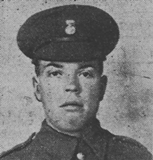
World War Two, 1939-1945
William Henry Fretwell, Lance Corporal, 7914847, Royal Tank Regiment. William was born at Nottingham on 21 February 1910, the son of Arthur and Ann Fretwell. The family later moved to Wales, and resided at Bryntirion, Llandderfel. William became the manager of the Bryntirion Inn at Llandderfel, and married Elen Gwynedd Jones, of Llanrwst, in 1936. Following the outbreak of war he enlisted into the army and was posted to the 46th Battalion, Royal Tank Regiment, known as the Liverpool Welsh, which was attached to the Royal Armoured Corps. The unit embarked for North Africa in May 1942, equipped with Valentine and Matilda tanks and saw its first major action on 22 July, suffering heavy losses. After several other smaller actions, the regiment took part in the Second Battle of El Alamein, but remained in Egypt when the Germans were pursued into Libya. The regiment took part in Operation Husky, the invasion of Sicily, from 10 July 1943, and then took part in the landings at Salerno from 9 September. On 22 January 1944 the regiment landed at Anzio, attached to the 1st Division, and saw further fighting in Italy before being transferred to Palestine, prior to moving to Greece in August 1944. William was killed near Athens on 2 January 1945. The 34-year-old is buried in Phaleron War Cemetery, Greece.
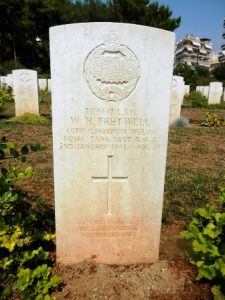
David Thomas Hughes, Serjeant, 7881710, Royal Welch Fusiliers. David was the son of David and Sarah Ellen Hughes, of Ty’nddol, Llandderfel. He married Elizabeth Hughes, of Conway early in 1942, just prior to embarking for North Africa with the Royal Welch Fusiliers to take part in Operation Torch, the landings on French North Africa. The landings took place at multiple locations along the North African coast on 8 November 1944. David was probably attached to another unit within the Eastern Task Force, which landed at Algiers on 8 November. He was killed in Algiers on 20 November 1942, the same day that the Allies recaptured Benghazi. The 34-year-old was originally buried in El Alia Cemetery, Algiers, but on 23 August 1944 his grave was among a number of others exhumed and re-interred in Dely Ibrahim War Cemetery, Algeria.
Douglas Vaughan Jones, Civilian. Douglas was born on 22 May 1872, the son of Edward and Ann Jones, of Llandderfel. He had moved to Bootle to find work by 1901 and in 1903 married Margaret Louisa Evans. Douglas was killed at home at 35, Southey Street, Bootle, when it was destroyed by a bomb during the Liverpool Blitz on 3 May 1941, aged 69. He is commemorated on the Civilian War Dead register at Westminster Cathedral. He is not commemorated on the Llandderfel memorial.
Idris Jones, Warrant Officer Class II, 4189505, Royal Welch Fusiliers. Idris was the son of David and Ellen Jones, and the husband of May Jones, of Tan-y-Craic, Llandderfel. He enlisted into the Royal Welch Fusiliers, and was posted to one of the infantry battalions of the 53rd (Welsh Division, probably the 7th RWF. Idris was attached to the 158th Infantry Brigade HQ, one of the three brigades of the 53rd (Welsh) Division. The Division spent much of the war on home service, moving from locations in Northern Ireland and South Wales to the South of England, and towards the end of June 1944 landed on the Normandy beaches, to take part in the drive out of the beach-head. The Division was utilised in defensive operations during its first weeks in Normandy, and then from 15 July, 158 Brigade took part in Operation Greenline, an offensive planned to capture the high ground from Bougy-Evrecy-Maizet, south of the Odon. Over the coming days, 158 Brigade saw heavy fighting, while 160 Brigade took part in a separate offensive, at Le Bon Repos crossroads. Idris was killed during this period of fighting, on 20 July 1944. The 34-year-old is buried in Brouay War Cemetery, France.
David Roland Williams, Sergeant, 1740034, Royal Air Force Volunteer Reserve. David was the son of Mrs. J. C. Williams, of Rhewl, Llangollen. He lived at Tremafon, Llandderfel prior to enlisting into the Royal Naval Volunteer Reserve, and after completing his training as an Air Gunner was posted to 614 Squadron, RAF. On 15 February 1944, 462 Squadron, Royal Australian Air Force, containing mostly British personnel, was granted permission to renumber, assuming the number of 614 Squadron, Royal Air Force, which had been disbanded in Sicily the previous month. The Squadron then moved to Celone, Italy, where it was equipped with the Handley Page Halifax, and took part in bombing missions over Italy and the Balkans, whilst also carrying out supply drops to partisan groups. On the night of 15 March 1944, a flight of aircraft from 614 Squadron took off from Celone, to carry out an attack on the railway marshalling yards at Sofia, Bulgaria. David was aboard Halifax BB446, flown by Pilot Officer Lyle Lawson, an experienced Australian pilot. The Halifax was the sole aircraft lost during the raid, presumed to have been shot down in the target area during the following morning of 15 March 1944, with all her crew assumed to have been killed. David was 20 years old when he was killed that morning, and is commemorated on the Malta Memorial, Malta.
